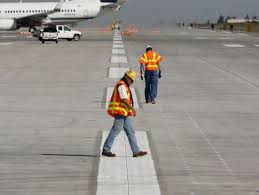Title Page
-
Self Assessment - Section 5 + 6
-
Conducted on
-
Prepared by
-
Location
-
Personnel involved
Critical Element 5 - Incident Recording, Reporting and Investigation
1. There is a system for reporting, recording and analysing incidents, injuries and work-related illnesses.
-
1. Documented procedure.
2. Incident and injury (accident) reporting forms.
3. On-site incident and injury (accident) registers
4. Procedures requiring early and prompt attention to all reported incidents and injuries.
5. Collation of all injury and incident data into a central record for analysis. -
Enter your findings, evidence reviewed and recommendations below
-
Select your judgment based on your findings
-
Enter any notes if you wish
2. Employees understand their specific responsibilities to report incidents, injuries and workplace illnesses that have or might have harmed anyone in the workplace.
-
1. Reporting systems available in all work areas (e.g.. forms in hard copy or on-line).
2. Staff communications, team briefings, health and safety meeting minutes.
3. Examples of completed incident and injury reports (where applicable). -
Enter your findings, evidence reviewed and recommendations below
-
Select your judgment based on your findings
-
Enter any notes if you wish
3. When a serious harm occurs to an employee the Occupational Safety and Health Service (OSH) of the Department of Labour is notified as soon as possible and a written report is sent within seven days. (NB: There are other agencies that the employer may also need to notify to meet regulatory obligations, in the event of a serious harm injury.)
-
1. Procedure to notify OSH including documented responsibility for notification.
2. Example(s) of notification within required timeframe when a serious harm injury has occurred (where applicable). -
Enter your findings, evidence reviewed and recommendations below
-
Select your judgment based on your findings
-
Enter any notes if you wish
4. The employer has a procedure to investigate incidents and injuries that harmed or might have harmed an employee.
-
1. Incident and injury investigation procedures
2. Designated incident and injury (accident) investigators.
3. Incident and injury (accident) investigation forms (forms in hard copy or on-line).
4. Incident and injury (accident) investigation example reports (where applicable). -
Enter your findings, evidence reviewed and recommendations below
-
Select your judgment based on your findings
-
Enter any notes if you wish
5. There is a procedure to ensure corrective action is undertaken in relation to any deficiencies identified during an investigation
-
1. Procedure for corrective action to be undertaken when deficiencies are identified in an investigation
2. Feedback into hazard management included in the process.
3. Responsibility for corrective action is assigned, time-bound, signed and dated as part of an incident and injury investigation and includes training and injury prevention feedback (where applicable).
4. Evidence of senior management* involvement and follow-up (e.g.. management minutes or communications -
Enter your findings, evidence reviewed and recommendations below
-
Select your judgment based on your findings
-
Enter any notes if you wish
6. Injury and incident data is reviewed to identify trends and provide information to managers and employees that can be used in injury prevention initiatives.
-
1. Process for at least annual review of collated data (e.g.. minutes of meetings, distribution of findings to management and employees).
2. Evidence of at least six monthly review of collated data (e.g.. minutes of meetings, distribution of findings to management and employees).
3. Evidence of injury prevention initiatives implemented where relevant (e.g.. changes in work practices, specific training). -
Enter your findings, evidence reviewed and recommendations below
-
Select your judgment based on your findings
-
Enter any notes if you wish
Critical Element 6 - Employee Participation
1. There is a forum (or series of forums) to enable communication between the employer, employees and union and other nominated employee representatives* on issues of interest and concern related to health and safety. (For a large or multi-site employer the number of forums should be appropriate to the size, type and geographic spread of the business, so that all employees have a "voice" through to management.)
-
1. Evidence of health and safety forum(s) that include the participation of management and employee representatives (e.g.. minutes of meetings).
2. Evidence of frequency of forum(s) at least quarterly (not applicable for new applications).
3. Evidence of on-going opportunity for joint involvement in injury prevention initiatives and, where applicable, injury management initiatives (e.g.. planning notes, outcomes of joint initiatives
4. Evidence of consultative development, monitoring and review of health and safety policies, processes and performance at least annually (e.g.. minutes or meetings, action plans, review documents -
Enter your findings, evidence reviewed and recommendations below
-
Select your judgment based on your findings
-
Enter any notes if you wish
2. There is a process agreed to by employees, to support union* and other nominated employee representative* involvement in health and safety development, monitoring and review.
-
1. Process for health and safety management that specifically supports employee involvement.
2. Evidence of agreed process to elect or endorse union* and other nominated employee representatives* to support health and safety
3. Evidence that information on this process is readily available and communicated to all staff. -
Enter your findings, evidence reviewed and recommendations below
-
Select your judgment based on your findings
-
Enter any notes if you wish
3. Health and safety training is provided to employees actively involved in health and safety management to assist in the development and establishment of safe workplace practices.
-
1. Evidence that health and safety training has been undertaken within the last two years.
-
Enter your findings, evidence reviewed and recommendations below
-
Select your judgment based on your findings
-
Enter any notes if you wish
Bearers
-
Bearers
Bearers shall be used to:
a) Support packs of woodproducts;
b) Support the woodproducts within the pack;
c) Keep packs off the ground; and
d) Allow space for fork-lift trucks to lift the pack.
7.2.3.1. Requirements for bearers
Bearers shall be, where practicable:
a) Straight and identical in length and cross-section (preferably square);
Note: If they are rectangular in section they are most stable when the long edge is horizontal
b) Of a length equal to the width of the pack (If too long they protrude, encouraging climbing of the stack, or can be easily struck by passing vehicles. Short or offset bearers do not fully support the pack above and increase the load on banding);
c) In good condition and shall be destroyed if rotten, damaged or split;
d) Made of a material strong enough to withstand the environment where the stack is constructed; and
e) Positioned carefully to prevent woodproduct in the supported pack from sagging and to avoid offsets in the stack. -
Enter your findings, evidence reviewed and recommendations below
-
Select your judgment based on your findings
-
Enter any notes if you wish
Stack Heights for Timber
-
Stack heights for timber
Where practicable, the maximum height of the stack shall not be more than four times the shortest width of the pack (i.e. a ratio of 4:1) in accordance with the relevant codes of practice and guidance notes in New Zealand, UK, Victoria and Queensland.
Note: The shortest width (i.e. base width) can be increased by the use of ties or adequately strapping adjacent stacks together. This in turn increases the allowable stack height whilst maintaining the 4:1 ratio.
Note: The actual stacking height should be determined after conducting a risk assessment which takes into account all conditions that may impact the stacking (e.g. risk of vehicle impact, slope of ground, effect of wind, proximity to pedestrians or public). While the maximum height allowed is a 4:1 ratio, the ratio may need to be reduced if there are conditions which would impact on the stability of the stack such as stability of ground surfaces or environmental effects such as high winds. -
Enter your findings, evidence reviewed and recommendations below
-
Select your judgment based on your findings
-
Enter any notes if you wish
Stack heights for other wood products
-
Stack heights for other wood products
The site shall determine stack height rules for other wood products, such as panels, plywood and LVL using a risk assessment which considers as a minimum:
a) The stability and stacking nature of the particular product;
b) Potential effects of natural hazards, such as wind and earthquake;
c) Risk of vehicle impact;
d) Condition of stacking surface; and
e) Proximity to pedestrians or the public.
Note: Notwithstanding the results of the risk assessment, panels can generally be stacked to a maximum of 6 high for 900mm packs and 8 high for 1200 mm width packs.
Board material is characteristically more stable than timber -
Enter your findings, evidence reviewed and recommendations below
-
Select your judgment based on your findings
-
Enter any notes if you wish
Standard Board Material
-
Stacking board material
When stacking board material:
a) Position centres of gravity of stacked packs directly above one another;
b) Ensure packs are not offset in such a way that they protrude from the stack;
c) Take into consideration the size and shape of packs before stacking;
d) Ensure packs do not bridge across two stacks or across other packs;
e) Ensure there is no loose material on top of stacks;
f) Stacks should not lean against or be supported by other stacks.
g) Store boards and similar flat articles flat on a level surface;
h) Ensure that when stacking boards on edge there is adequate support to prevent movement; and
i) Protect exposed corners at the ends of aisles with, for example, bollards or stanchions. -
Enter your findings, evidence reviewed and recommendations below
-
Select your judgment based on your findings
-
Enter any notes if you wish
Timber Pack Characteristics
-
Timber pack characteristics
Individual packs of sawn timber shall meet the following requirements:
a) Where practicable, the timber in the pack shall all be of the same cross-section and length;
b) Collapsed or partially collapsed packs shall be identified in a stack, removed and rectified using an established safe system of work;
c) The tops of packs shall be kept level which will help to form a vertical stack; and
d) Separating sticks (dunnage), with a length equal to the pack width, shall be used, where required, to form a tight square pack and prevent balling or rolling. -
Enter your findings, evidence reviewed and recommendations below
-
Select your judgment based on your findings
-
Enter any notes if you wish
Binding / Strapping Product
-
Binding/Strapping woodproducts
Binding or strapping shall be used to secure packs and meet the following criteria:
a) Consideration shall be given to whether the material is likely to expand or contract due to the surrounding storage conditions or treatment (i.e. timber with a high moisture content will shrink and the binding/strapping may come loose and need to be reapplied);
b) Binding/strapping material shall be suitable for the demands to which it will be subjected (PET 2040H strapping is generally recommended);
c) Space between woodproducts shall be minimised to ensure a tight and secure pack is achieved;
d) Bands /straps shall be applied squarely (i.e. parallel to the plane of the end face), close to columns of sticks within the pack;
e) Bands/straps shall be tight to the face of the pack and not be applied over the ends of protruding sticks or bearers;
f) Binding/strapping fasteners shall be suitable for the pack and banding material;
g) Ensure that the assembly and strapping system used tightly packs the bottom layers (as pack strapping is tensioned from the top, so the base of the pack may not be tight);
h) Correct cutting tools for cutting bands, straps or wire shall be used at all times;
i) Employees shall be trained in the safe procedures for binding/strapping of product for dispatch/delivery and removal of banding/strapping;
j) Adequate provision for the safe disposal of strapping shall be provided;
k) The size of the packs and their binding/strapping system shall be appropriate to restrain all individual pieces of woodproduct;
l) All packets of block-stacked woodproduct shall be suitably bound at a point as near as possible to where they have been assembled; and
m) All binders shall be set square to the packet. -
Enter your findings, evidence reviewed and recommendations below
-
Select your judgment based on your findings
-
Enter any notes if you wish
Strapping SOP's and training
-
Strapping SOPs and training
Where applicable, each site is to have a specific SOP and training program for strapping that includes, as a minimum:
a) Preference for use of plastic strapping, where practicable;
b) Use of cutting tools;
c) Required PPE;
d) Safe strapping and cutting techniques (e.g. stand to side, hand on top);
e) Correct disposal methods; and
f) Requirement for removal of all straps when breaking down a pack. -
Enter your findings, evidence reviewed and recommendations below
-
Select your judgment based on your findings
-
Enter any notes if you wish
Periodic Inspections
-
Periodic inspections
Periodic inspection shall be undertaken to identify any deficiencies in the banding/strapping (e.g. loose bands and loss of pack shape).
Note: If problems are detected, the packs concerned should be re-banded or the banding re-tensioned. If the same problems occur on a regular basis, the type of banding being used should be reviewed, for example, a stronger band may be needed or a different type of fastener. -
Enter your findings, evidence reviewed and recommendations below
-
Select your judgment based on your findings
-
Enter any notes if you wish
Binding Packets for Transportation
-
Binding packets for transportation
Packets to be transported shall be:
a) Tightly put together, particularly at the base;
b) Bound with at least two strategically placed binders of equal or greater strength than 10-gauge 3.2 high-tensile wire, with a breaking strain of 661 kg, suitably tensioned and secured;
c) Constructed and bound so they are able to withstand a horizontal acceleration equivalent to half the weight of the packet.
Note: If there is any doubt concerning this capability, then a simple tilt test can be carried out. The packet shall be able to withstand a sideways tilt angle of at least 26° before showing signs of any significant distortion. -
Enter your findings, evidence reviewed and recommendations below
-
Select your judgment based on your findings
-
Enter any notes if you wish
Breaking down stacks and packets
-
Breaking down stacks and packets
When breaking down woodproducts stacks and packets the following shall apply:
a) If more than one person is concerned in this operation, one only shall be responsible for the manner in which the stack is reduced;
b) Binders shall not be cut unless everyone is in a position of safety in case any part of the stack timber stacking and packeting collapses or part of the binder flies back;
c) Binders shall not be cut by any person standing on a stack unless it is adequately supported on both sides;
d) If it seems apparent that any part of a stack or packet will collapse when the binder is cut, the packet shall be suitably stayed or held together by a forklift or other means;
e) The packet shall be taken down layer by layer rather than tier by tier, ensuring that the remaining part is in a safe condition; and
f) Fillets, spacers, wires and straps shall be disposed of in an appropriate manner so as not to become a tripping hazard. -
Enter your findings, evidence reviewed and recommendations below
-
Select your judgment based on your findings
-
Enter any notes if you wish
Log storage
-
Log storage
Logs shall be stacked in accordance with the following requirements:
a) Log storage areas shall be separated from pedestrian and vehicle routes to reduce the risk of persons being in the area in the event of a log stack collapsing;
b) People shall be prohibited from climbing on log stacks;
c) Wheel loaders with suitable grab attachments shall be used to stack and de-stack logs;
d) Where practicable, stack heights shall be limited to the log length and be compatible with the methods of stacking and de-stacking (usually maximum 3 – 4 m high);
e) Stacks shall comply with a maximum stacking angle of 45o generally and, where separation of persons and log stacks is not practicable, 35o in pedestrian areas; and
f) The use of wedges and stanchions shall be applied to fix the logs at the front and back of stacks to prevent them from rolling. -
Enter your findings, evidence reviewed and recommendations below
-
Select your judgment based on your findings
-
Enter any notes if you wish
Saw dust and wood chip/fibre storage
-
Saw dust and wood chip/fibre storage
Saw dust and wood chip shall be stored in accordance with the following requirements:
a) Public access must be restricted to stockpiles of sawdust and woodchips;
b) Procedures shall be established for the safe unloading of bins, in particular for unblocking the discharge chute and filter maintenance;
c) Entry into storage containers shall be subject to confined space regulations and standards;
d) Dust generation shall be minimised when unloading storage bins.
e) Where it is not practicable to control dust in other ways, personal protective equipment (e.g. P1 respirator and eye protection) shall be used;
f) Naked flames and other sources of ignition shall be controlled to reduce the risk of wood dust explosion;
g) Piles of woodchips shall be used in rotation and cleared so that the chips cannot stand for long periods of time;
h) Stockpiles of sawdust and woodchip shall be located away from overhead powerlines or sources of combustion and clear of waterways;
i) Precautions shall be taken to ensure that dust from stockpiles does not impose on people or neighbouring properties;
j) Woodchip and sawdust stockpiles must be maintained in a manner to eliminate the threat of collapse;
k) When constructing a free standing stockpile, the base should be as wide as practicable to avoid slippage;
l) When working on a stockpile, care must be taken not to drive vehicles over unstable material, particularly near the edge of the main access path;
m) When excavating a stockpile, care must be taken not to leave shear faces exposed and the face must be left at a safe angle to prevent collapse;
n) Stockpiles shall be monitored for temperature build up and signs of combustion;
o) Where practicable, stockpiles shall be completely removed and a new stockpile made at regular intervals; and
p) Adequate fire fighting equipment shall be on hand to defend against fire. -
Enter your findings, evidence reviewed and recommendations below
-
Select your judgment based on your findings
-
Enter any notes if you wish
Plastic Drums
-
Plastic Drums (Use of wedges)
Where drums are stacked on their sides, wedges shall be fixed at the ends of each row to prevent movement. -
Enter your findings, evidence reviewed and recommendations below
-
Select your judgment based on your findings
-
Enter any notes if you wish
Plastic Drums (ideal storage conditions)
-
Plastic Drums (Ideal storage conditions)
Where practicable, drums shall be stored in accordance with the following requirements:
a) Level concrete floor, free of any objects, such as rocks, sticks, pipes;
b) Proper double-faced (top and bottom deck boards) pallets in good condition;
c) Drums shall be properly closed per manufacturers closing instructions;
d) Temperatures in the storage area shall not exceed 32o C;
e) No exposure to direct sunlight;
f) Drums shall be UN rated and the contents well within the type and specific gravity rating on the drums; and
g) Drums and contents in a stack shall be all the same. -
Enter your findings, evidence reviewed and recommendations below
-
Select your judgment based on your findings
-
Enter any notes if you wish
Factors that lower the recommended stack height (negative factors)
-
Factors that lower the recommended stack height (negative factors)
Stack heights shall be reduced where conditions do not meet the ideal conditions specified in section 7.5.2 above, including:
a) High temperature environment, exceeding 32o C for extended periods;
b) Drums filled to less than their nominal rated capacity;
c) Stacked drums exposed to direct sunlight for extended periods; and
d) Drum closures fitted with pressure relieving vents. -
Enter your findings, evidence reviewed and recommendations below
-
Select your judgment based on your findings
-
Enter any notes if you wish
Pallet Stacking (Drums)
-
Pallet Stacking (Drums)
Pallets and drums shall be vertically aligned in the stack, drums shall not overhang pallet edges and stacking heights shall be in accordance with the following:
a) Four-high stacking (sixteen drums, four per pallet) is only recommended if conditions are ideal and all other factors have been considered (i.e. a single negative factor will limit the stack height to less than four-high);
b) Typical maximum stack height for full plastic drums is three-high; and
c) Where there is a combination of negative factors the maximum stack height shall be reduced to two-high. -
Enter your findings, evidence reviewed and recommendations below
-
Select your judgment based on your findings
-
Enter any notes if you wish
Column Stacking (Drums)
-
Column Stacking (Drums)
Where column stacking is used, full 19mm plywood boards shall be used between drums and a maximum stack height of two-high applies. -
Enter your findings, evidence reviewed and recommendations below
-
Select your judgment based on your findings
-
Enter any notes if you wish
Pyramid Stacking (Drums)
-
Pyramid Stacking (Drums)
Where pyramid stacking is used, a bottom footring or ¾” plywood boards shall be used between drums and a maximum stack height of two-high applies. -
Enter your findings, evidence reviewed and recommendations below
-
Select your judgment based on your findings
-
Enter any notes if you wish
Horizontal Drum Storage
-
Horizontal Drum Storage
Filled drums stored in a horizontal position shall not be directly stacked and each horizontal drum shall be supported individually at the length of the each drum, at the middle, and at both ends. -
Enter your findings, evidence reviewed and recommendations below
-
Select your judgment based on your findings
-
Enter any notes if you wish
Paper Reels
-
Paper reels
The following controls are required in reel storage areas:
a) Floors shall be kept clean and free of loose paper;
b) Other combustible material shall not be kept in the reel store;
c) Damaged reels shall be repaired by taping or rewrapping;
d) Where reels are stacked vertically, the spaces between them shall be less than 100 mm, where practicable;
e) Alternatively, spaces shall be wide enough (more than 1.1 m) to allow normal access;
f) Vertically stacked, banded reels in purpose-built separate buildings with proper fire separation, venting and restricted access may be stacked as high as can be safely achieved with the stacking equipment; and
g) Frequent inspection and checks by supervision. -
Enter your findings, evidence reviewed and recommendations below
-
Select your judgment based on your findings
-
Enter any notes if you wish
Bagged Goods
-
Bagged goods
Bagged goods shall be stacked such that:
a) The first tier is so arranged that the bags can be spread flat;
b) The same is done in succeeding tiers;
c) Interlocking is used where practicable;
d) Bagged material of differing sizes and shapes (e.g. seeds, granules, pellets) are not stacked on top of each other unless controls are implemented to prevent movement by settling or vibration.
e) Pallets with spacers or some form of horizontal bonding are used if there is a risk of such movement or if it is intended, or necessary, to stack high;
f) Special precautions are taken with synthetic bags or sacks, which have a tendency to slip when new; and
g) Where practicable, the mouths of the bags shall be on the inside of the stack. -
Enter your findings, evidence reviewed and recommendations below
-
Select your judgment based on your findings
-
Enter any notes if you wish
Stacking Bales
-
Bales
Bales shall be stacked with care to ensure their stability, taking into consideration:
a) Possible vibration;
b) Ability to lean stacks into their centre; and
c) The tendency of synthetic bales to slip when new. -
Enter your findings, evidence reviewed and recommendations below
-
Select your judgment based on your findings
-
Enter any notes if you wish
Paper bale storage
-
Paper bale storage
Bales of paper shall be stored in accordance with the following requirements:
a) Bales should be neatly stacked;
b) Stacks should be limited in size to reduce the fire loading and laid out in straight rows with adequate aisles between stacks that allow easy access for fire fighting;
c) Aisles shall be as wide as practicable to prevent fire spread through radiated heat;
d) Housekeeping shall be to a high standard with regular sweeping up to prevent loose paper accumulating;
e) Aisles shall be kept clear of all debris or material that could impede escape or hinder fire fighting;
f) A system of work shall be in place to restrict pedestrian access to bale storage areas; and
g) Smoking shall be forbidden in storage areas. -
Enter your findings, evidence reviewed and recommendations below
-
Select your judgment based on your findings
-
Enter any notes if you wish
Bale Stack Heights - indoor
-
Bale stack heights - Indoor storage
Bales shall have a maximum height of 5 m and in all cases be a minimum of 3 m below the roof/ceiling and a minimum 1 m below the level of the sprinklers. -
Enter your findings, evidence reviewed and recommendations below
-
Select your judgment based on your findings
-
Enter any notes if you wish
Bales - Outdoor Storage
-
Bales Outdoor storage
Where practicable:
a) Stacks shall not exceed 6 m in height; and
b) Stacks shall be separated from one another by aisles at least three times the height of the highest adjacent stack, with a minimum of 15 m between stacks. -
Enter your findings, evidence reviewed and recommendations below
-
Select your judgment based on your findings
-
Enter any notes if you wish
Sheet Materials
-
Sheet materials
Sheet materials, including glass, shall be stacked in such a way that:
a) Sheets are stacked flat or on edge;
b) Sharp edges are protected to prevent injury to workers and passers-by.
c) The supports used in edge-on stacking must be of adequate strength to bear the side thrust of the vertical sheets;
d) Extra care is taken when stacking and handling glass; and
e) Consideration is given to the weight of metal and glass sheet in bulk so that racks and flooring are not overloaded. -
Enter your findings, evidence reviewed and recommendations below
-
Select your judgment based on your findings
-
Enter any notes if you wish
General Rules
-
De-stacking – General rules
When breaking down stacks, the following shall apply, where applicable:
a) Only one person shall be responsible for the manner in which the stack is reduced;
b) All stacking and destacking should be carried out under competent supervision;
c) Before unstacking, the stack shall be examined to see how it was constructed and to check for signs of instability or faults such as broken bands, bearers or sticks, and pack balling;
d) Identify any packs which are bridging other stacks or packs;
e) Take down packs tier by tier;
f) Move only one at a time;
g) Do not leave isolated single stacks;
h) Do not remove individual pieces of timber from packs until they are on the ground and the working area is safe; and
i) If access is required to the top of the stack an appropriate method shall be used consistent with Standard 03-10-01 Working at Height. -
Enter your findings, evidence reviewed and recommendations below
-
Select your judgment based on your findings
-
Enter any notes if you wish














